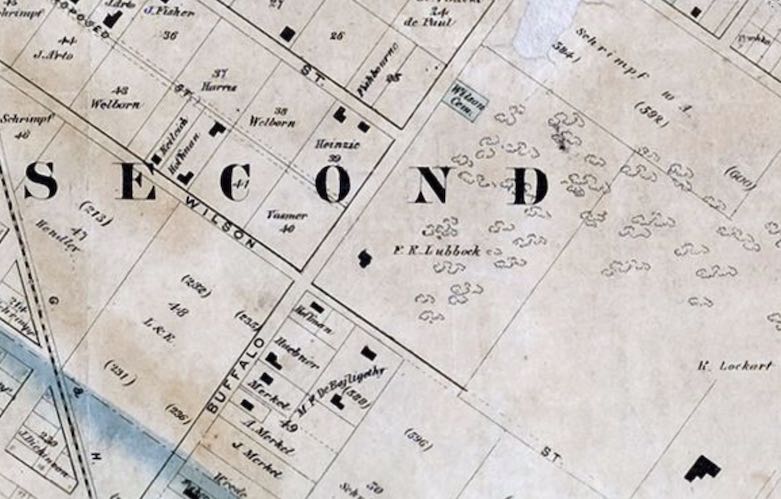Lubbock's Grove
This grove was used in post-Civil War Houston for large festivals like the German Volks-fest, and possibly at least one Juneteenth celebration. It was described in 1871 as being “a lovely spot about one mile east of town.”1

Selection from 1869 Houston Map showing Lubbock’s Grove.
The grove evidently took its name from the owner of the property, Francis Lubbock, but it may sometimes have been referred to as Lockart’s or Lockhart’s Grove, after the neighboring property owner (and brother-in-law of Lubbock) who may also have managed the grounds.2 Some contemporary articles also located the grove with reference to property owned by Judge M. F. DeBagligethy.3
Triangulating these names suggests that the grove is the one depicted with Lubbock’s name on the 1869 City map near intersection of Commerce/Wilson and Buffalo in the Second Ward.
See an 1872 painting of the Lockart House at Houston Public Library.
A Fourth of July celebration and barbecue was held in Lockhart’s grove in 1856.4
And in April 1866, “Mr. Barron, of Frost Town,” gave a May party for his school “in the grove between Mr. Lockheart’s residence and the city.”5
For more on the site, Lubbock, and Lockart, “a Pennsylvania-born merchant who owned and operated a steam grist mill on San Jacinto and Franklin Streets,” who married Francis Lubbock’s sister, see Thomas McWhorter’s article on Second Ward.6
According to yates1985—which described the grove (p. 32) as “strikingly noticeable for its natural beauty in a setting of green trees, their branches reaching outward and upward, with tops majestically outlined by the blue sky above”—Lubbock’s Grove was considered as a possible site for Juneteenth celebrations prior to the purchase of Emancipation Park, and it may even have hosted the event in 1869. But among the problems with the site was its distance from the Fourth and Third Ward neighborhoods where Black Houstonians lived at the time.
Picnics
In 1870, students at the Sabbath School of the M. E. Church used the grove for a picnic, and were joined “at Allen’s Station by the Sunday School of the same Church of that neighborhood.”7
In 1872, it was used by students from the Gregory Institute: see WPA Files at HHRC.
Volks-Fest
The first German Volksfest appears to have been held in 1869 in the grove. See coverage in early June 1869 issues of the Houston Times, especially June 8, which described the grand procession (“without doubt, the most imposing procession ever witnessed in this city”) with decorated wagons to Lubbock’s Grove, where beer stands, firewords, dancing, speeches, prizes and competitions ensued. The German organizers depicted it as an apolitical recreational event for the city.
The Times used the Volks-fest in June 1869 to argue for the creation of a permanent space for such festivities:
The great success of the recent German festival held in this city, convinces every one that the establishment of permanent pleasure grounds near the city is worthy of earnest consideration. We have, on more than one occasion, alluded to the fact that subscriptions are open for this purpose and that nearly $1000 worth of stock has already been taken. The shares are placed at $5 currency, each. The desires is that the subscribers or stockholders shall represent “the masses” and hence it is hoped that all will interest themselves in the enterprise. It is estimated that $6000 will purchase and fit up suitable grounds, for the purpose. Out of a population of 20,000 persons there are certainly 1000 who can spare $5 for this purpose without thinking about dividends on the investment, other than the amusement that will be derived therefrom. A number of gentlemen of means have already said they would subscribe liberally. Don’t let them do it. Let it be a “people garden”—let us adopt the plan of our German fellow citizens and spend our money for our own amusement, not to enrich a few.
Will not some of the young ladies take the matter in hand? Take the lists to your husbands and sweethearts. They won’t refuse you, and when we have the gardens you can tell them to close their business early and drive you out, away from the dust and turmoil of the city. …8
See also the plea for public spaces in 1866 City Directory, p. 118.
An article in the Houston Chronicle, August 21, 1911, AHN, identifies the grove as the grounds for Volksfest in 1875.
“The Volks-Fest,” Houston Daily Union, May 5, 1871, AHN.↩
Robert Lockart, a real estate dealer, appears in the 1877-1878 city directory residing “n s Commerce e of Union depot.” In 1886, he posts an advertisement offer a reward “for any information leading to the conviction of the party who cut the wire fence inclosing Lubbock’s Grove.” See Houston Post, December 10, 1886, AHN. He is again linked to the grove in an article in the Post on May 23, 1893, in a report about a petition to run an electric street railway through the grove.↩
See “Horticulture and Floriculture,” from Houston Daily Union, September 28, 1870 (AHN), which places Lockhart’s Grove near the home of Judge M. F. DeBagligethy. A later article says that the “De Bajligethy Ice Cream Park” on Commerce Street was located “opposite Lubbock’s Grove.” See Houston Post, May 31, 1893.↩
“Fourth of July,” Houston Weekly Telegraph, July 2, 1856, link.↩
Thomas McWhorter, “From Das Zweiter to El Segundo, A Brief History of Houston’s Second Ward,” Houston History 8, no. 1 (Fall 2010), 38–42, link.↩
“The International Gardens,” Houston Times, June 11, 1869.↩
